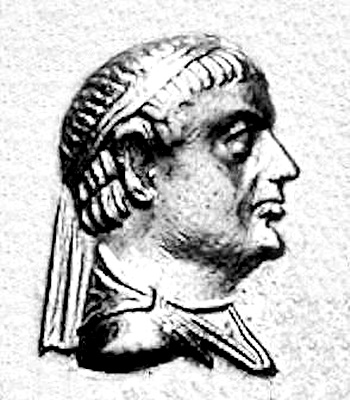.jpg)
Hermaios and Calliope
Coins
Hermaios (also spelled Hermaues) was a Western Indo-Greek king of the Eucratid Dynasty, ruling in the region of Paropamisade (the Hindu-Kush area, with his capital at Alexandria of the Caucasus, near present-day Kabul, Afghanistan) during the first quarter of the first century BCE. He is recognized as the last Greek king to rule in Gandhara and the Kabul valley before the area was overtaken by nomadic invaders, notably the Yuezhi. Calliope (also spelled Kalliope) was an Indo-Greek queen, known as the wife of Hermaios. Their joint rule is notable for several reasons. Hermaios and Calliope issued joint silver drachms, which are remarkable for depicting the busts of both rulers on the obverse-Hermaios diademed and draped, and Calliope draped and wearing a stephane (a type of crown).The reverse of these coins typically shows Hermaios on a prancing horse, a motif common among Greek kings in eastern Punjab at the time.The appearance of a queen alongside the king on Indo-Greek coinage is rare, suggesting that Calliope held a special status or that their marriage represented a significant dynastic or political alliance.

Lysimachus
Coins
Lysimachus (c. 360–281 BCE) was a Macedonian general and one of Alexander the Great’s somotophylax (bodyguard), who became a major Hellenistic king ruling territories spanning Thrace, Asia Minor, and Macedonia.Reign: Satrap of Thrace (323–306 BCE); King (306–281 BCE). Territories: Thrace, western Asia Minor, Macedonia (briefly), and parts of Greece. Notable Achievements: Founded Lysimachia (309 BCE) to secure the Dardanelles. Defeated Antigonus I at the Battle of Ipsus (301 BCE), expanding into Asia Minor. Conquered Macedonia (285 BCE) from Demetrius I. Early Career: Served as Alexander’s bodyguard during campaigns in Persia and India. Satrap of Thrace: Appointed in 323 BCE, spent years subduing Thracian tribes (e.g., Seuthes III) and rebellious Greek cities. Diadochi Conflicts: Allied with Ptolemy I, Cassander, and Seleucus I against Antigonus I, securing his position through strategic marriages.

Menander I
Coins
Menander I (Milinda) was the most prominent Indo-Greek king, ruling from c. 165 BCE to 130 BCE and expanding Hellenistic influence deep into northern India.Territory: Extended from Bactria (Afghanistan) to the Ganges Valley, including Punjab, Gandhara, and parts of Rajasthan. Capital: Sagala (modern Sialkot, Pakistan).Expansion: Conquered territories as far as Pataliputra (Patna), fulfilling Alexander the Great’s unrealized goal. Conflict: Faced incursions from Eucratides I (Greco-Bactrian king) in the northwest but retained control over Punjab and the Indus Valley. Legacy: His coins, found from Kabul to Mathura, attest to extensive trade and political influence.

Apollodotus II
Coins
Apollodotus II (reigned c. 80–65 BCE) was a significant Indo-Greek king who revived Hellenistic influence in northwestern India during a period of Scythian incursions.Territory: Ruled western and eastern Punjab, recapturing Taxila from the Indo-Scythian king Maues or his successors. Dynasty: Likely part of Menander I’s lineage, using Menander’s title Soter (\"Savior\") and reverse design of Athena Alkidemos.
